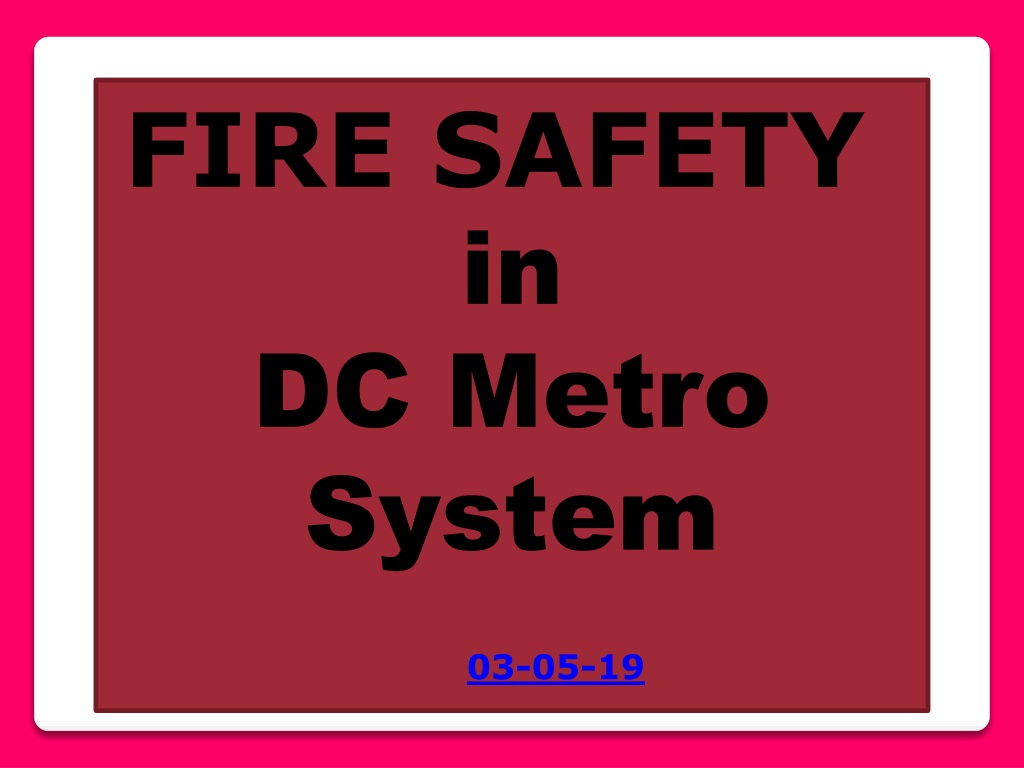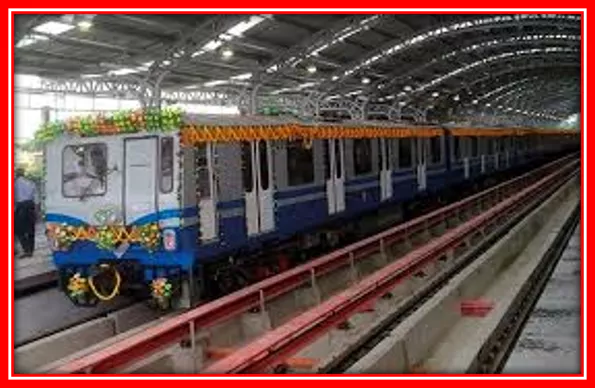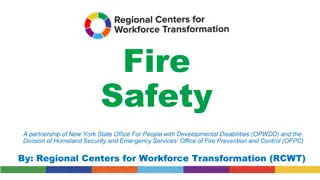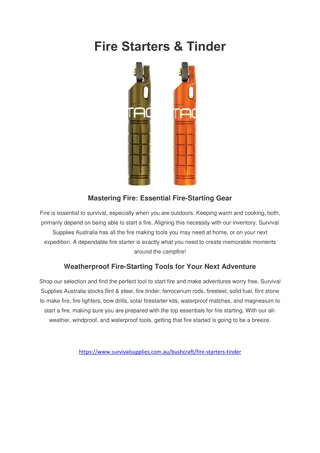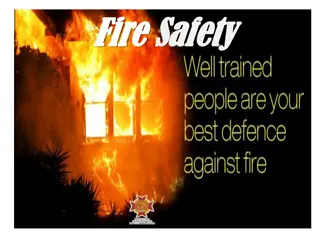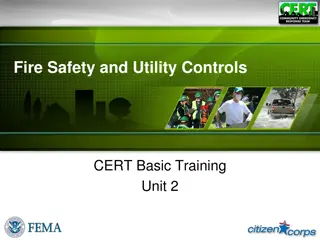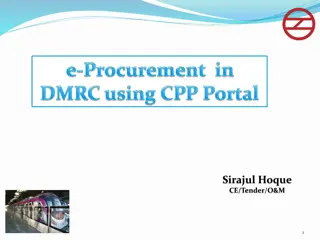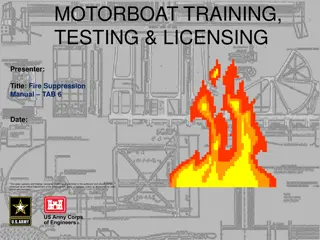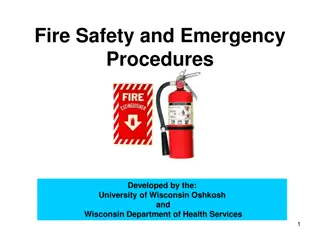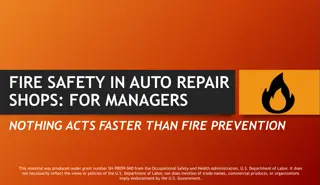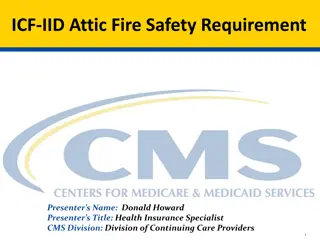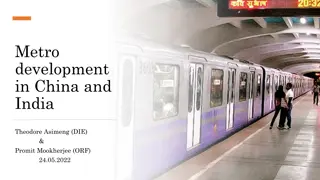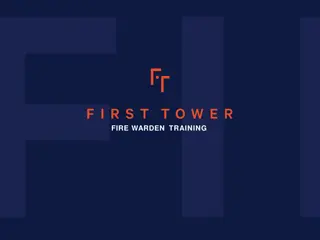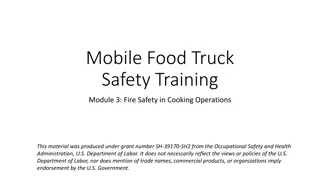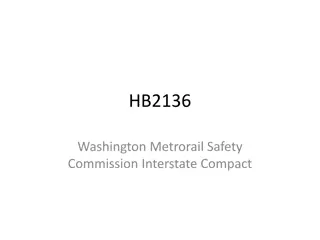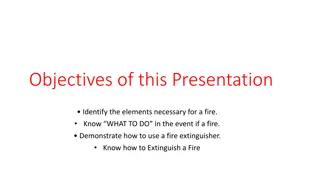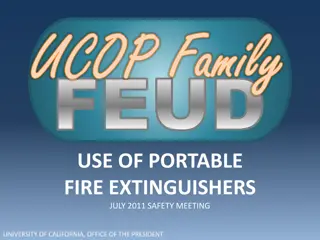Fire Safety Measures in DC Metro System
Learn about fire safety in the DC Metro System, including the risks of combustion in composite materials, relevant safety specifications from various standards organizations, and essential fire safety measures such as detection systems, fire suppression, and emergency lighting. Explore the importance of materials with fire retardant properties to enhance passenger safety.
Download Presentation

Please find below an Image/Link to download the presentation.
The content on the website is provided AS IS for your information and personal use only. It may not be sold, licensed, or shared on other websites without obtaining consent from the author.If you encounter any issues during the download, it is possible that the publisher has removed the file from their server.
You are allowed to download the files provided on this website for personal or commercial use, subject to the condition that they are used lawfully. All files are the property of their respective owners.
The content on the website is provided AS IS for your information and personal use only. It may not be sold, licensed, or shared on other websites without obtaining consent from the author.
E N D
Presentation Transcript
FIRE SAFETY in DC Metro System 03-05-19
FIRE Composite do not burn in fire but volatile components vaporizing from the substrate .Polymer heats up & begins to decompose thermally Gases generated will ignite in presence of oxygen & begin to burn Flame spread depends on heat released, temperature will begin to rise until entire fire load decomposes rapidly with the evolution of flammable gas mixture Ignition of gas causes an explosive rate of fire spread within the confines of the space, (railway carriage) referred to as flashover and leads to fully developed fire
SAFETY American Specification European Specification National Fire Prevention Association NFPA130:2017 British Standard French Germany UIC DIN 5510 BS 6853 Standard for fixing Guidway Transit and Passenger rake system NFF 16- 101,102
French Standard (NFF-16- 101,102) British Standard (BS 6853 Fire Behaviour :Choice of Materials Combines reaction to fire, (M-rating), with smoke and toxicity, (F-rating). The M/F rating dependent type of rolling stock, tunnels usage & position orientation of composite part Code of practice for fire precautions in the design and construction of passenger carrying trains R-Index a single number quantification of the toxic gas risk associated with candidate composite materials generated from the analysis of eight gases German standard s (DIN 5510- 1,2) Preventive Fire Protection in Railway Vehicles. Part 1 - Levels of protection, fire protection methods and certification Part 2 - Fire behavior and fire side effects of materials and parts - Classification, requirements and test methods
On range of On range of independen independen ce measure ce measure Detection & Detection & alarm alarm system system Fire Fire resistance. resistance. Manual/Aut Manual/Aut omatic fire omatic fire suppression suppression Compartme Compartme ntation ntation Emergency Emergency lighting lighting Ventilation Ventilation BS 6853 SALIENT POINTS Control of Control of materials/c materials/c ontents. ontents. Way Way guidance guidance system system Staff Staff Escape & Escape & egress egress provision provision managemen managemen t t Escape Escape route/exit route/exit door door widths. widths. Normal Normal supervision supervision Occupancy Occupancy level level
Descriptio n Specifi cation Fire Retardant Property Characteristics Fire Retar dant Low Smok e Polycarbon ate Passenger Seat ICF/MD /Spec- 197/Pt- II UL 94, ISO 4589, Tendency to either extinguish or spread the flame once the specimen has been ignited. YES YES IEC 60695-2-12 NCD 1409 It conforms to V-0 & V-2 class rating which means burning stops within 10 & 30 seconds respectively on a vertical specimen. TOXICITY as per NCD 1409 (AC & MEDHA Rake) EXAMPLE PVC Flooring sheet ICF/MD /Spec- 235 EN- 13501-1, UIC 564-2 Class A EN-13501 provides reaction to fire classification procedure for all products and building elements. YES YES NCD 1409 (Amd. 01) TOXICITY as per NCD 1409 Rubberized flooring UIC 564-2, DIN 5510-2, Fire behaviour, Smoke density, Toxicity & Oxygen index are specified. OEM YES YES EN 45545, ASTM E-648, E-662 Spec (MEDHA Rake) BS 6853, ISO 4589
NFPA 130: 2017 EMERGENCY VENTILATION STATIONS TRAINWAYS EMERGENCY PROCEDURES EMERGENCY COMMUNICATIONS VEHICLES CONTROL & COMMUNICATIONS WIRE & CABLE REQUIREMENTS GENERAL
EN 45545: 2013 Prevent fires occurring due to technical faults , equipment design or vehicle layout Minimize possibility of ignition of materials installed on railway vehicles due to accidents or vandalism Detect a fire should it occur Limit the spread of fire by specification of materials according to their operational categories and by measures for containment Minimize effects of fire in terms of heat, smoke and toxic gases on passengers or staff through specification of materials installed on railway vehicles Control and manage a fire, by means of fire detection, suppression , emergency energy shut down
Holistic approach of fire safety performance-based design methodology Materials Part : 2 Operating conditions Part : 1 EN45545- 1 to 7 Fire detection/ suppression Part : 6 Barriers Part : 3 Train Design Part : 4,5,7 35 European countries mandatory follow
EN45545-1 Operational Category Overview Running Time Operational Category 1 Surface Operation No Tunnels/ Elevated Sections Longer Than 1 km Vehicles may stop with minimum delay Operational Category 2 Metro - Tunnel Operation No Tunnels/ Elevated Sections Longer Than 5 km, Side Evacuation Possible 4 Min Operational Category 3 Inter-City Tunnel Operation Tunnels/ Elevated Sections Longer Than 5 km (Up to 20 km), Side Evacuation Possible 15 Min Operational Category 4 Metro - Tunnel Operation Restricted Evacuation No Tunnels/ Elevated Sections Longer Than 5 km Side Evacuation NOT Possible (London Underground Tube Operation) 4 Min
Design Category A: Vehicles forming part of an automatic train having no emergency trained staff on board D: Double decked vehicles S: Sleeping and couchette vehicles N: All other vehicles (standard vehicles) EN45545-2 Hazard Level Combination of Operation & Design Category Operating category Design Category N A D S 1 HL1 HL1 HL1 HL2 2 HL2 HL2 HL2 HL2 3 HL2 HL2 HL2 HL3 4 HL3 HL3 HL3 HL3
EN 45545-2 : Requirements for fire behavior of Material & components Spread of Flame(ISO 5658) CFE Heat Release Rate (ISO 5660) MAHRE Smoke Density (ISO 5659) VOF4,Ds Toxic Gas Emissions (ISO 5659) CIT Rise of flame & OXYGEN INDEX(ISO 4589) EN45545-3: FIRE BARRIER Fire Barriers EN45545-3 Barriers Element intended for use in maintaining separation between two adjacent areas of railway vehicle fie which resists to passage of flame and/or heat and/or effluents for a period of time under specified conditions
EN45545-4: Fire safety requirements fot Rolling Stock Design EN45545-4 Rolling Stock design Running Capability (Refers to EN50553) Emergency Exits Evacuation and Escape Measures HVAC ,visibility EN45545-5: Electrical Equipmets including trolley buses, maglev EN45545-5 gives comprehensive design Code of Conduct to minimise the risk of a Fire Starting in Electrical Applications Key Topics: Management of risk areas for key equipment. Electrical Overload Protection Protection from Electrical Arc Requirements for Cabinets/ Ducting
EN 45545-6: Fire control & Management Systems , Fires on trains are Detected and Reported by Passengers and Staff. EN45545-6 requires comprehensive Fire Detection systems 9 Possible Detector Locations (e.g. Passenger Areas, Toilets, Technical Cabinets) Requirement for Automatic Detection changes, based on Operational Category and Design Category EN 45545-6 defines requirements for Portable Fire extinguishers on trains EN45545-7: Flammable liquids & Flammable Gas Installations EN45545-7 specifies key requirements for management of flammable liquids on board trains Key Areas include: Flammable liquid tanks and pipe work requirements Requirements for Internal Combustion engines
Trends in Metro Design from safety 1. EMERGENCY EVACUATION SIDE EVACUATION FRONT EVACUATION BETTER KAUN?? 2. NUMBER OF COACHES IN RAKE?? 3. VENTILATION SYSYTEM IN CASE OF EXIGENCY Emergency mode , dampers of circulating air closed so that can operate with fresh air only. In case of smoke outside , dampers of fresh air to close and circulating /return air should remain open to provide air
DC SYSTEM : NO JUGAD TSS HSCB DC FUSE COACH HSCB COORDINATION BETWEEN SAFETY V/S RELAIBILITY
CLEARANCE & CREEPAGE DISTANCE ( EN 50124) CLEARANCE: Shortest distance in air between two conductive parts CREEPAGE DISTANCE: Shortest distance along the surface of the insulating material between two conductive parts. POLLUTION: For creepage distances and clearances 7 degrees of pollution IEC 60664-1 and IEC 60077-1 broken down into PD3A, PD4, PD4A and PD4B to cover railway applications. INSULATING MATERIAL (w.r.t comparative tracking index-CTI) Materials are separated into four groups according to either their CTI values as defined in IEC 60112 or their class as determined by IEC 60587 tests. Above 1000 V Above 500 V Material Groups PD1 PD2 PD3 PD3A PD4 PD4A PD4B I 3.2 5 12.5 20 25 30 40 II 4 7.1 14 25 30 40 50 IIIA 6 10 16 32 Not recommended
Flame retardant designed for use in fire situations where the spread of flame along a cable route needs to be retarded. Governing standard IEC 60332 , BS 4066 , UL Standard for Fire retardant cables. Fire resistant (FR) cables those are designed to maintain circuit integrity of those vital emergency circuits during fire. Governing standard IEC 60331, BS 6387 Fire rated cables
Fire resistance test as per IEC 60331 Test carried out on the cable operational on load and burning at a temperature of 750 Deg C for 3 hours & circuit integrity must be uninterrupted. After the 3 hours, the fire and power is switched off. cable should report as usual when energized again after a gap of 12 hours. IEC 60331-2 : Test method for fire with shock at a temperature of at least 830 C for cables of rated voltage up to and including 0,6/1,0 kV and with an overall diameter not exceeding 20 mm IEC 60331-3 : Test method for fire with shock at a temperature of at least 830 C for cables of rated voltage up to and including 0,6/1,0 kV tested in a metal enclosure IEC 60331-11 : Apparatus - Fire alone at a flame temperature of at least 750 C IEC 60331-21 ed1.0 (1999-04) - Part 21: Procedures and requirements Cables of rated voltage up to and including 0,6/1,0 kV
WAY F0RWARD.. SAFETY LEGISLATION FOR METRO & MRTS ROLLING STOCK mainly based on EN 45545 SYSTEM DESIGN based on NFPA 130 PANEL OF APPROVED SAFETY AUDITORS TO ENSURE COMPLIANC: DESIGN VERIFICATION, VALIDATION ,FINAL CERTIFICATION SETTING OF PROPER LABS IN INDIA RAMS MUST BE MADE MANDATORY AND PROPERLY EXPLAINED
